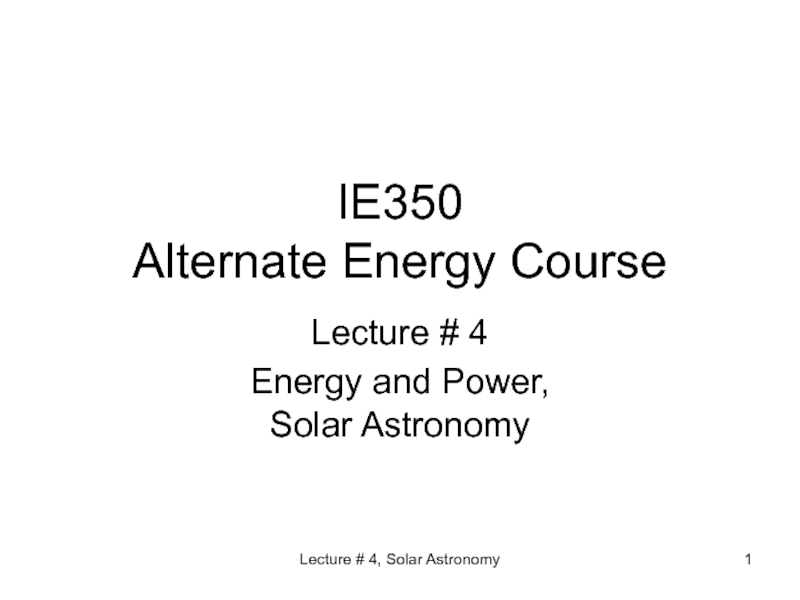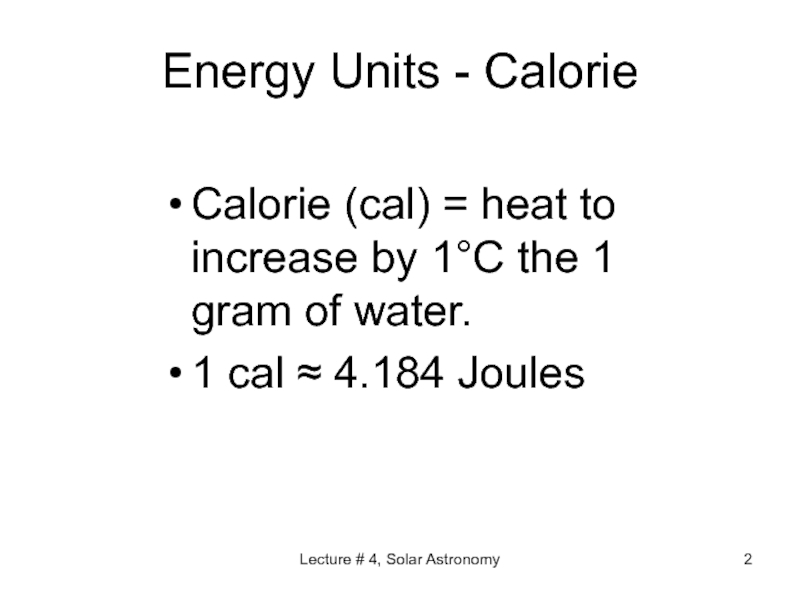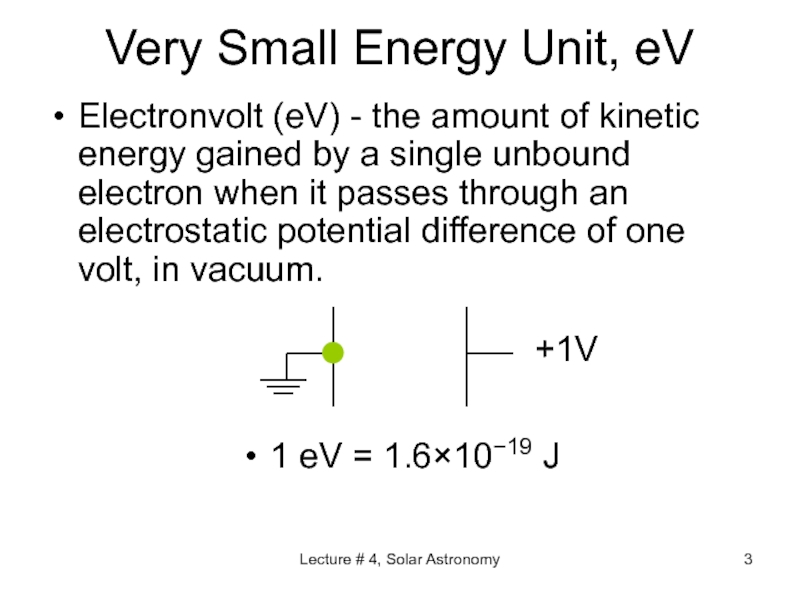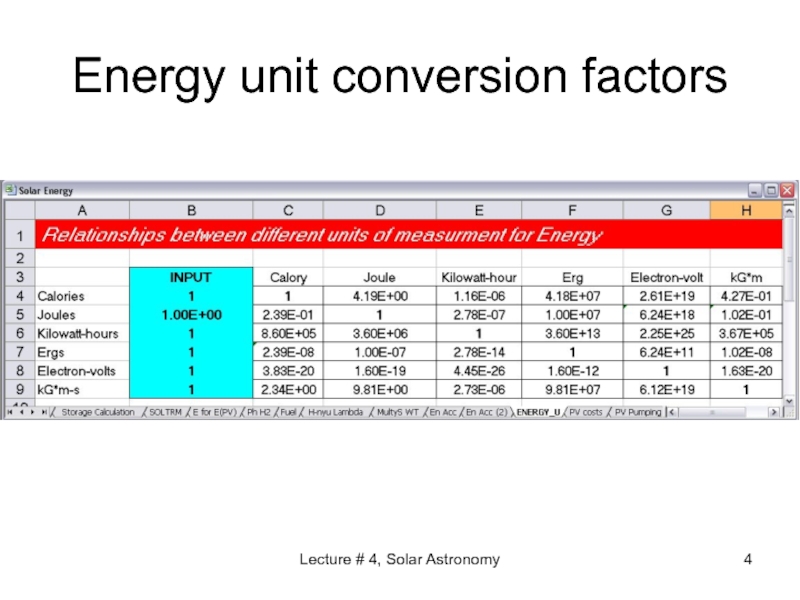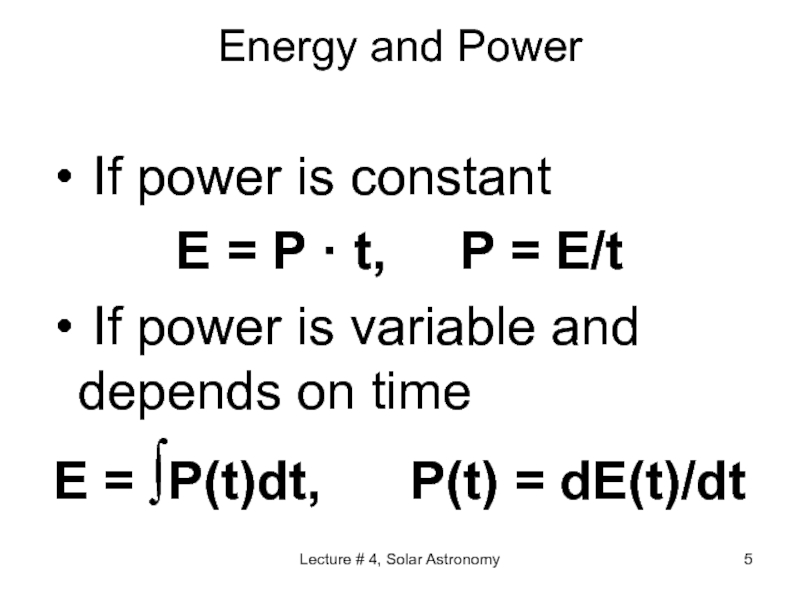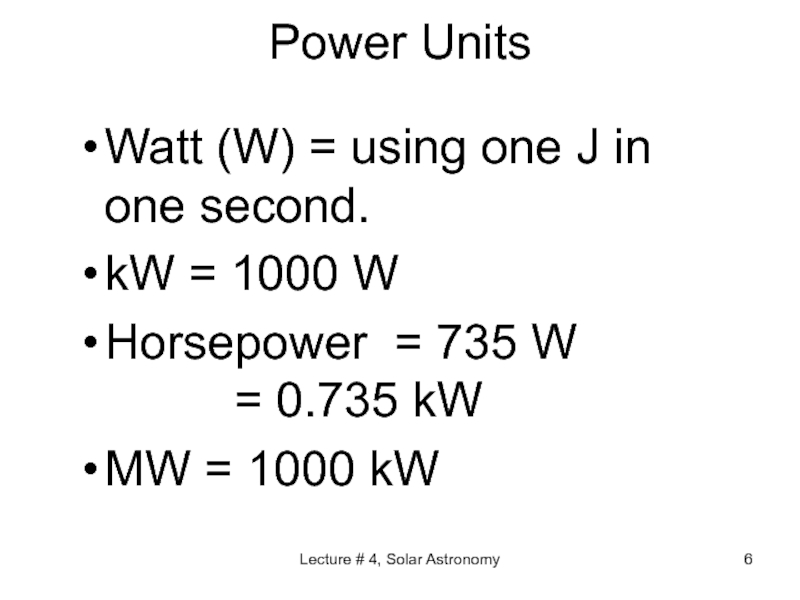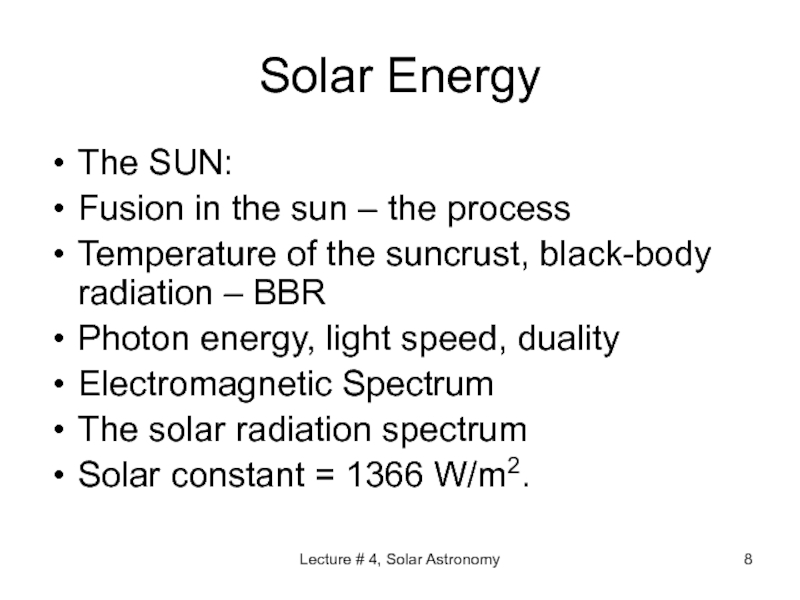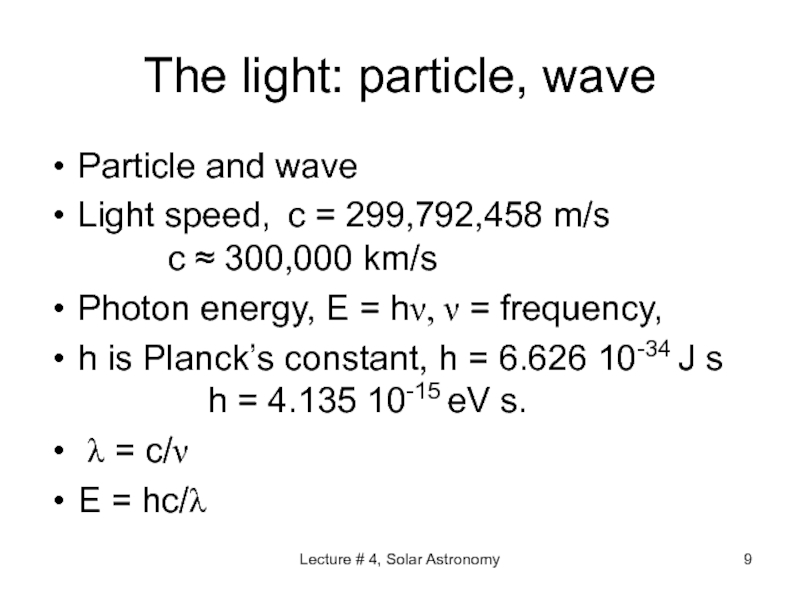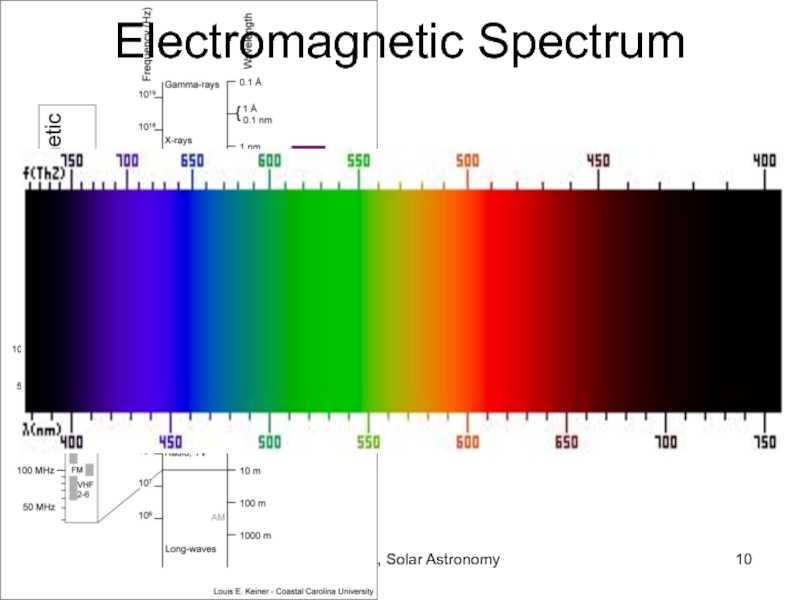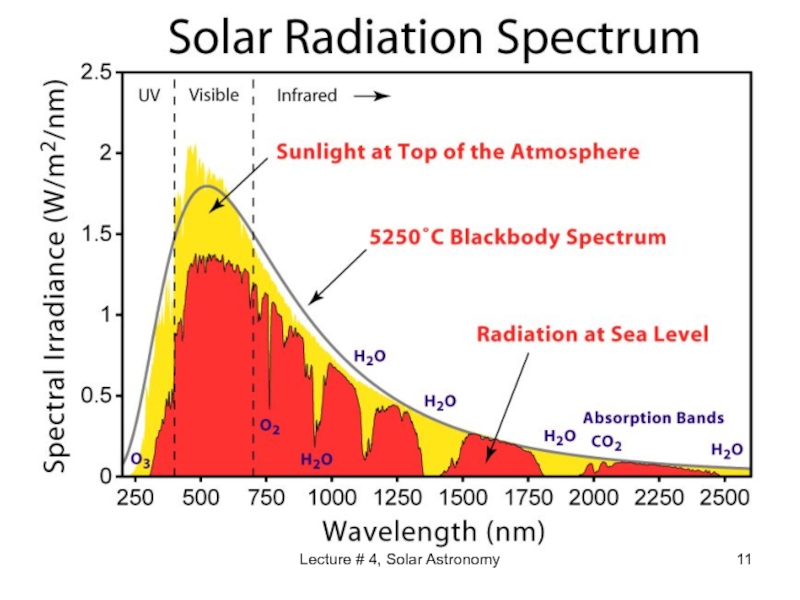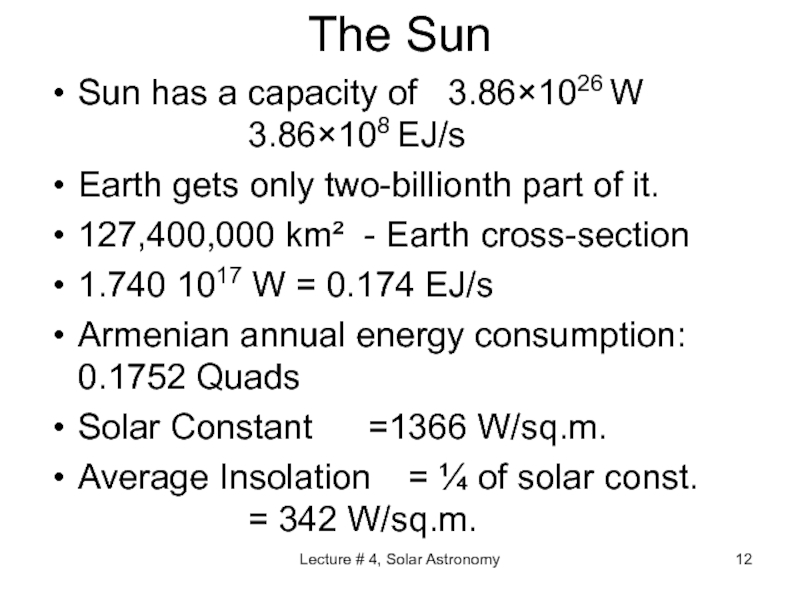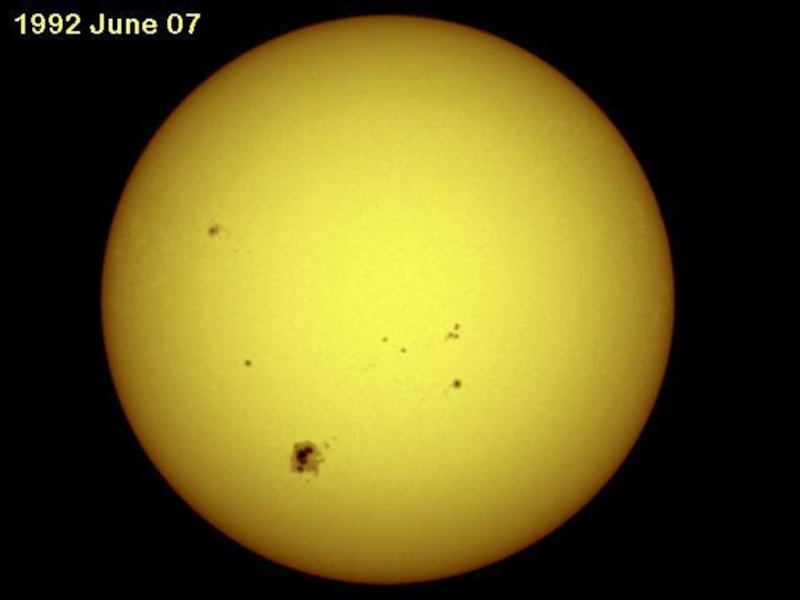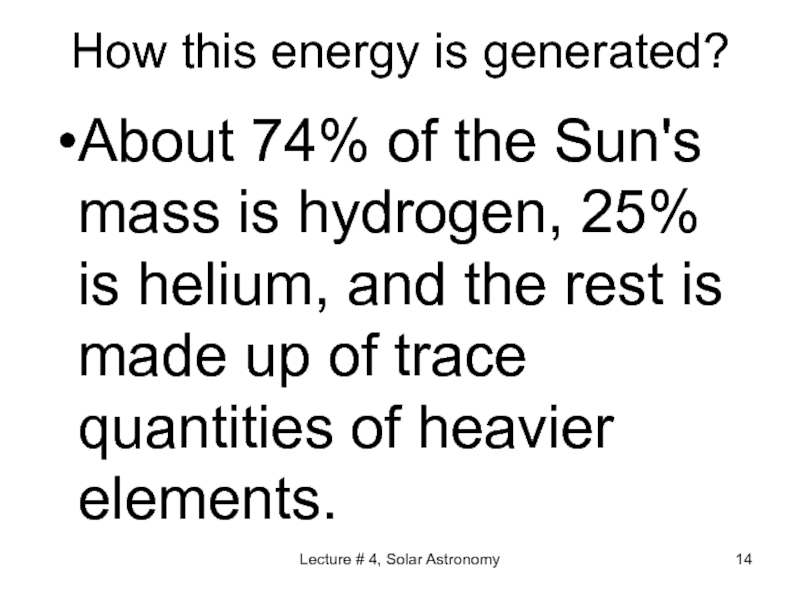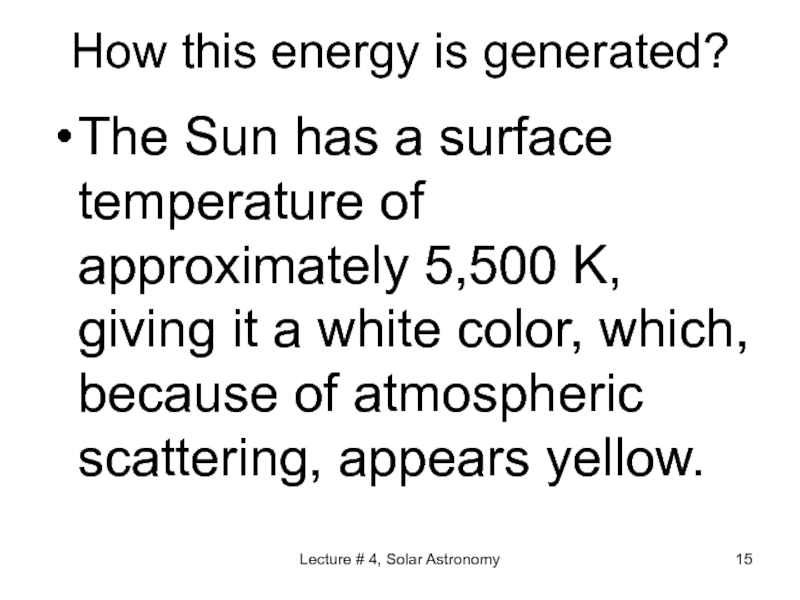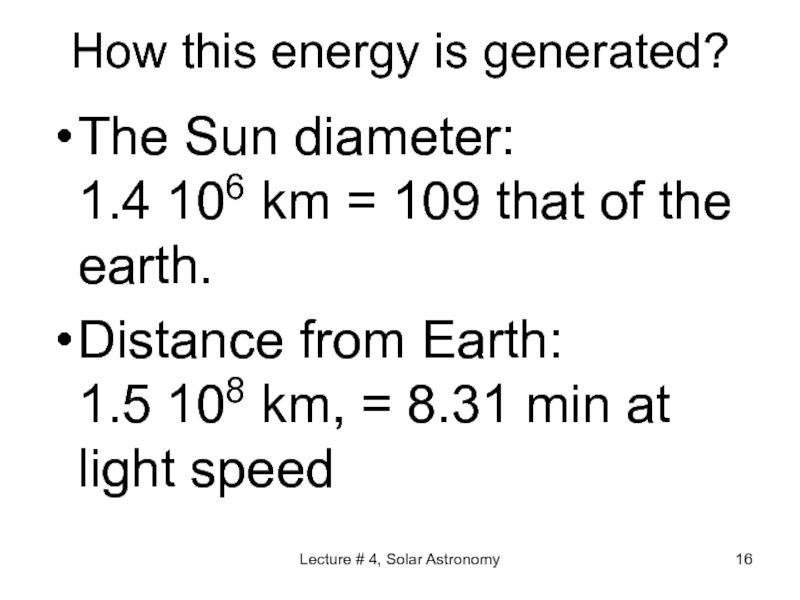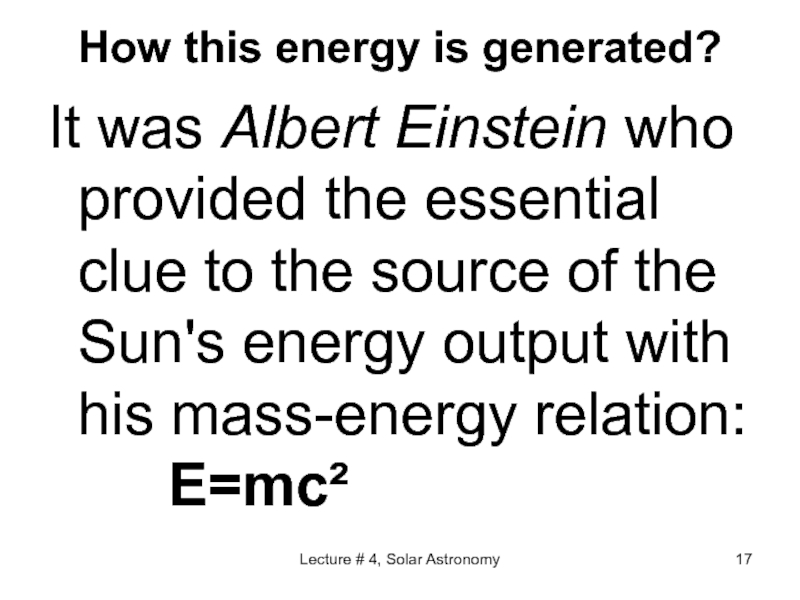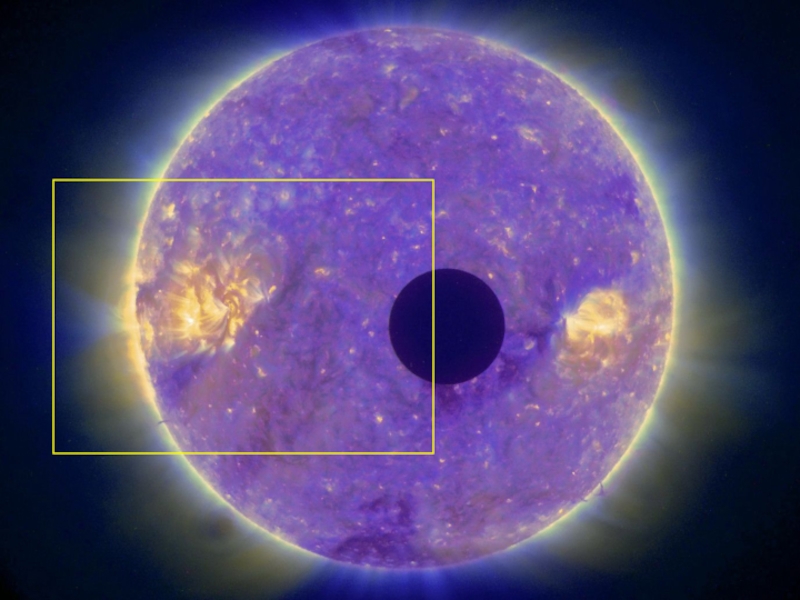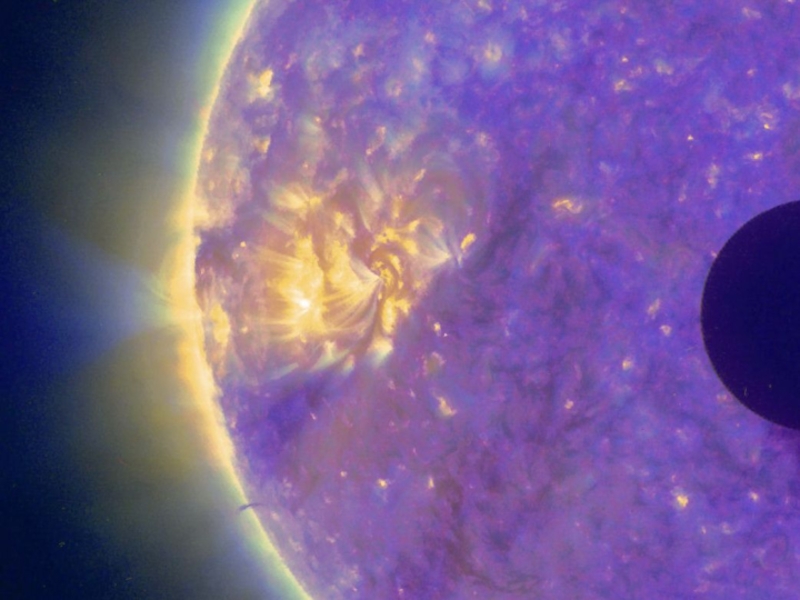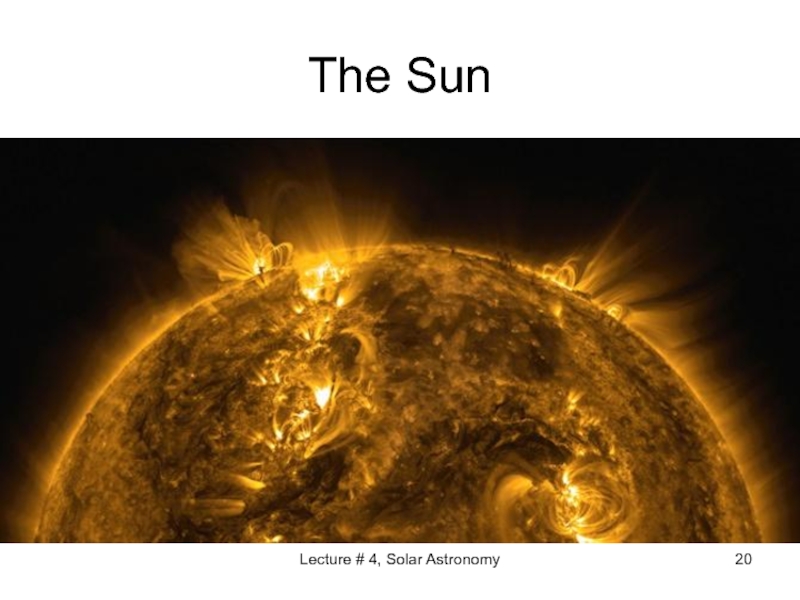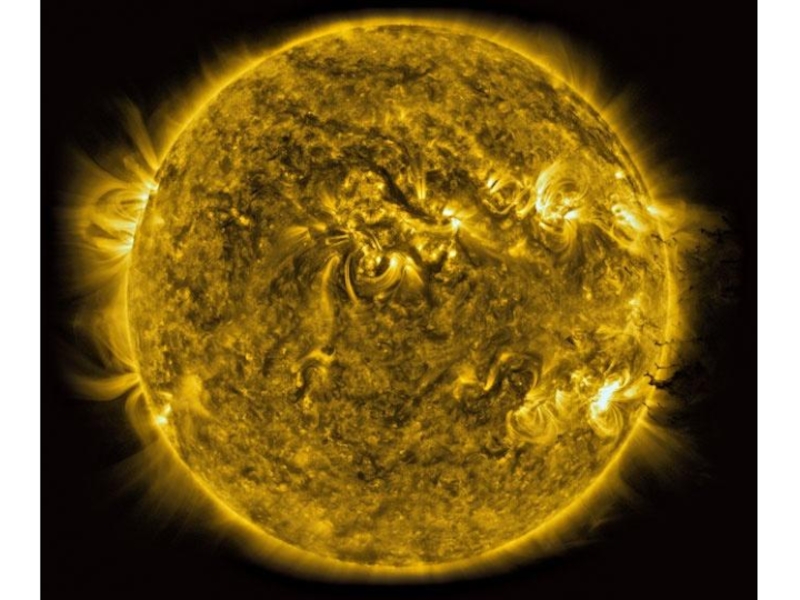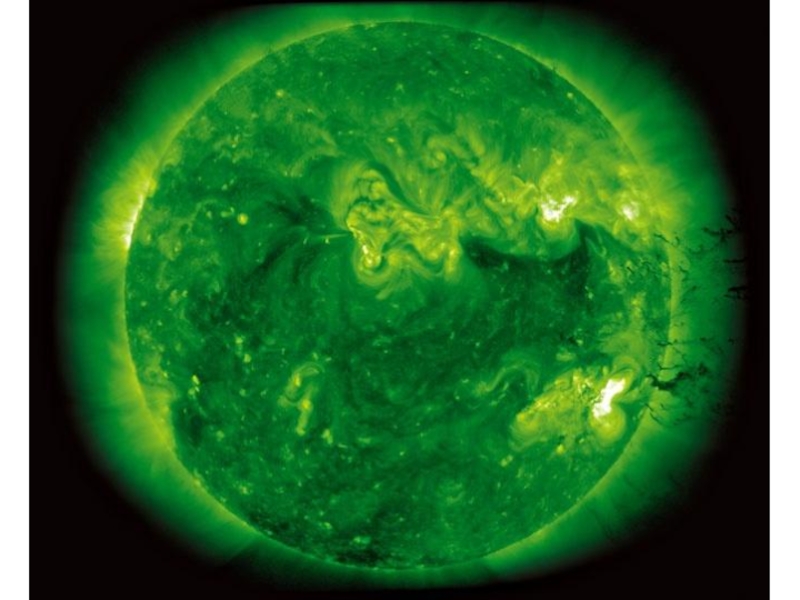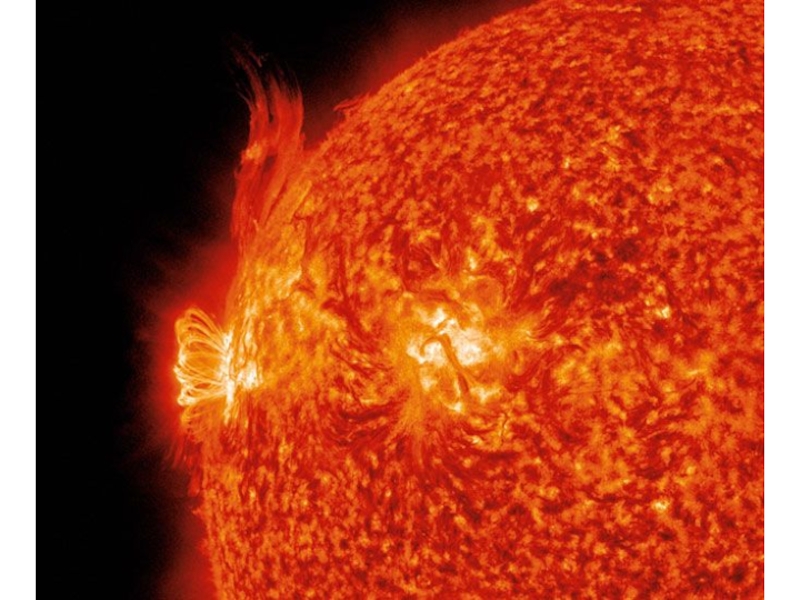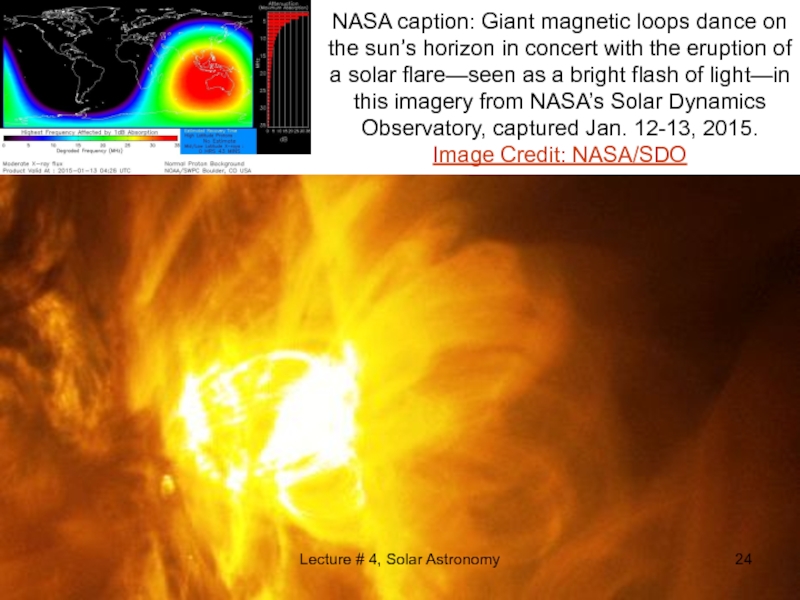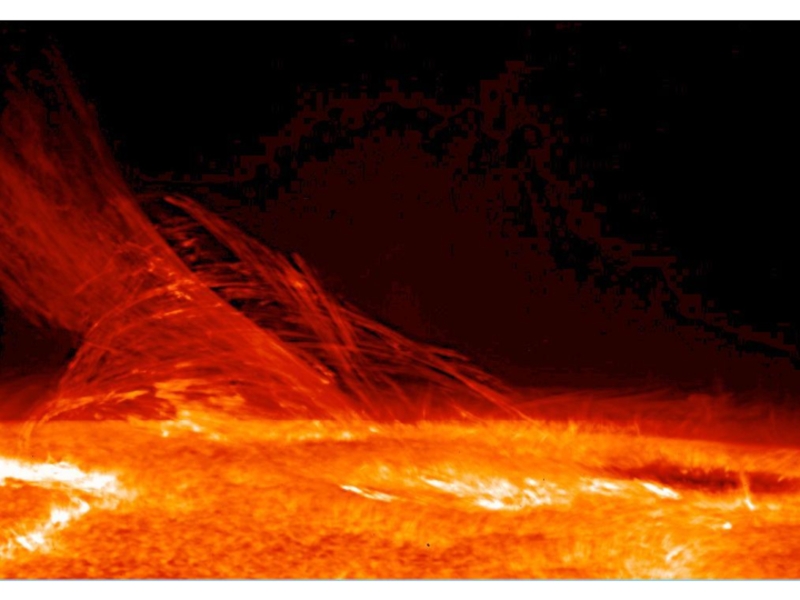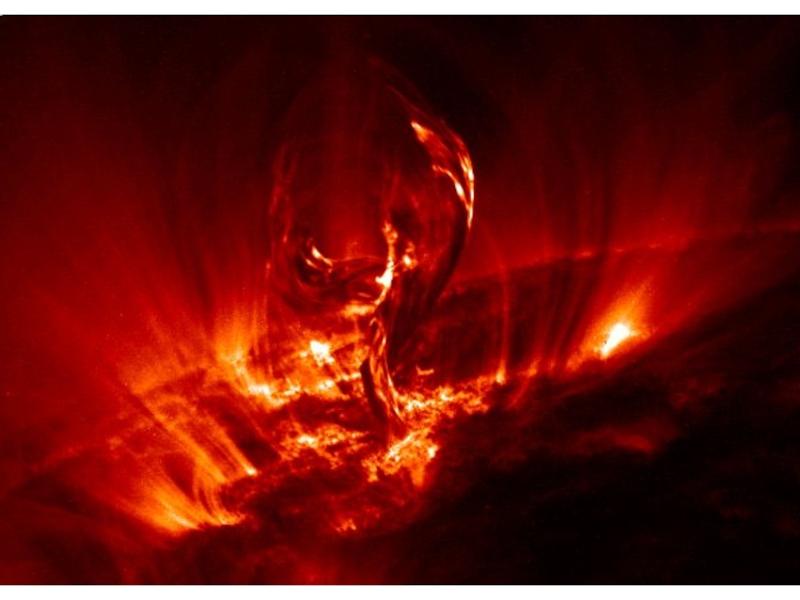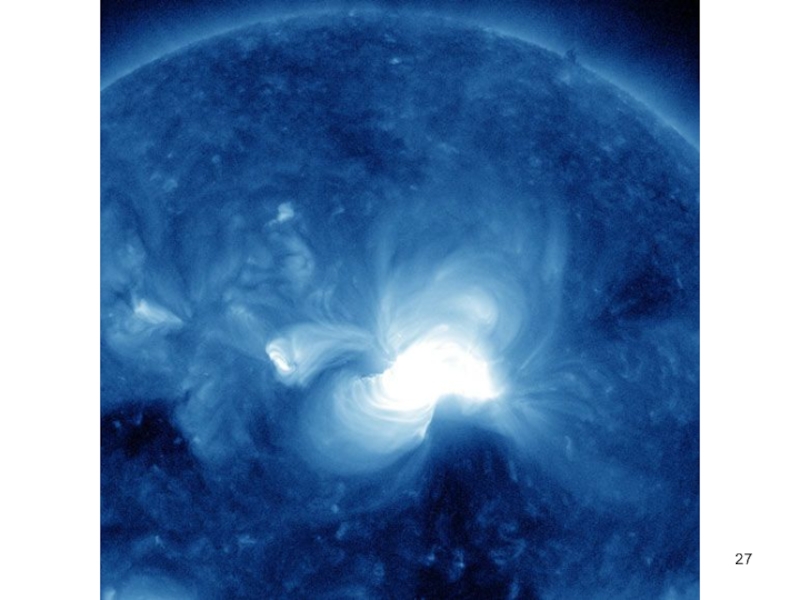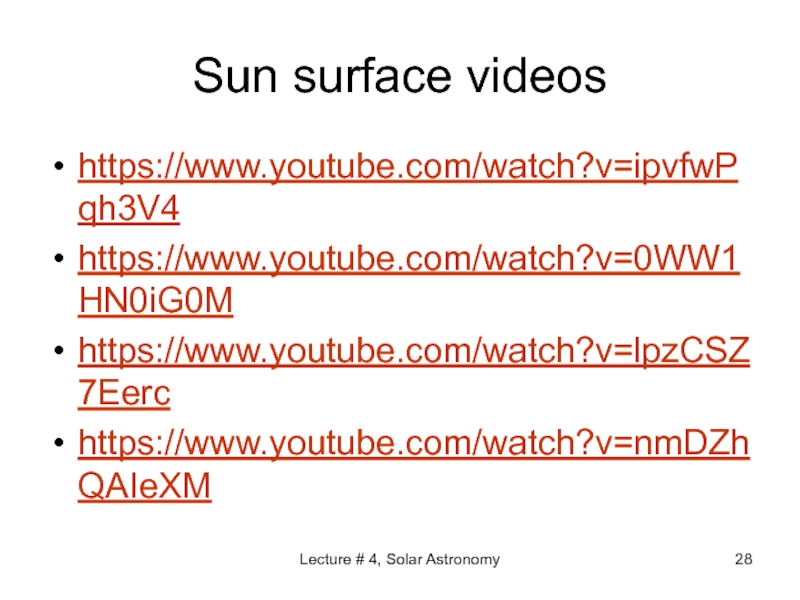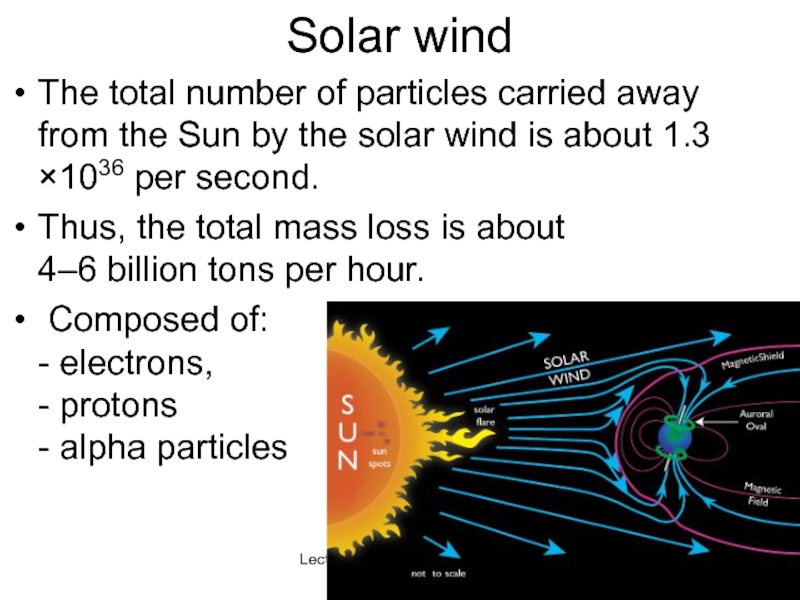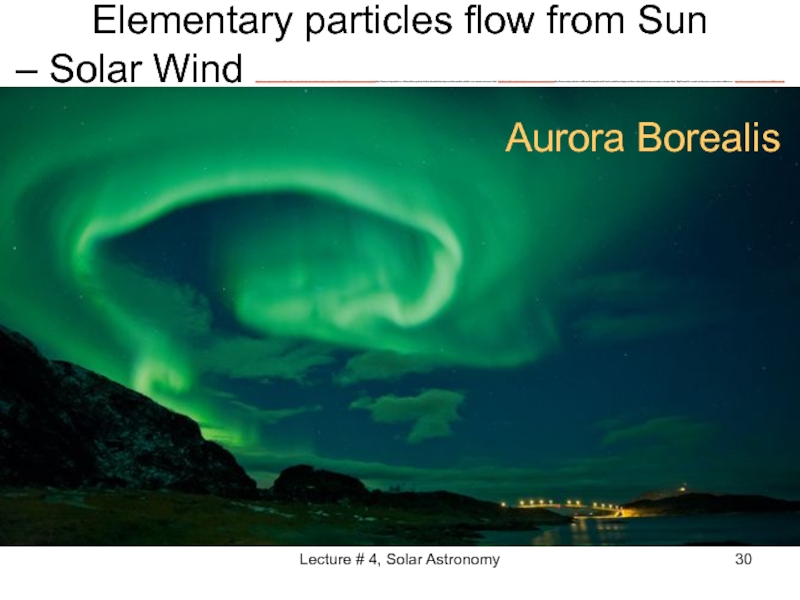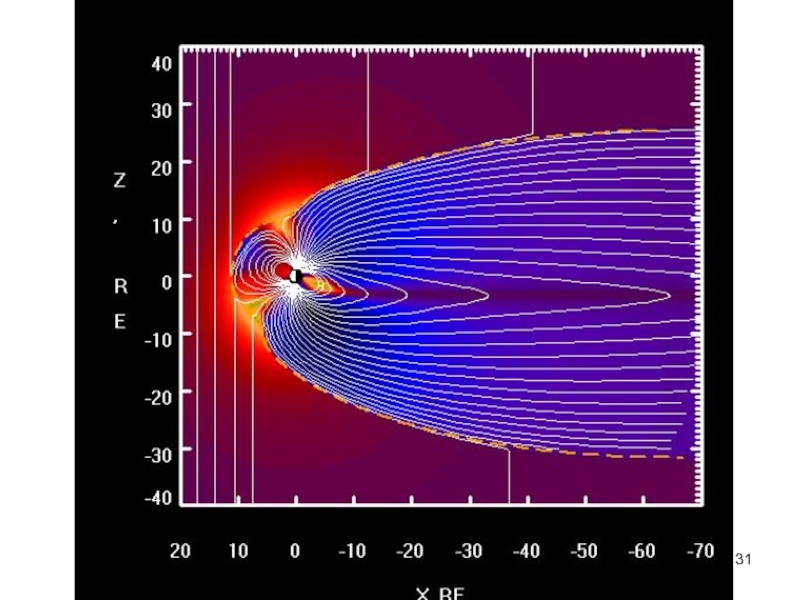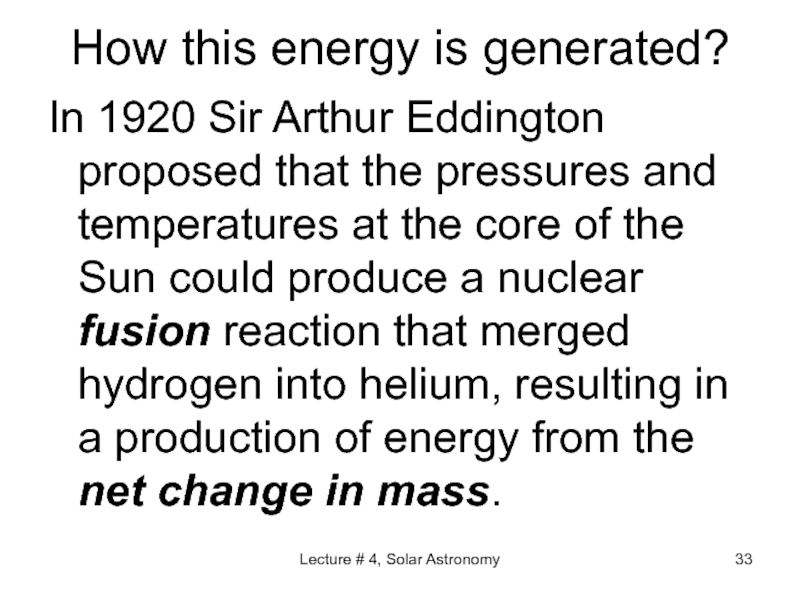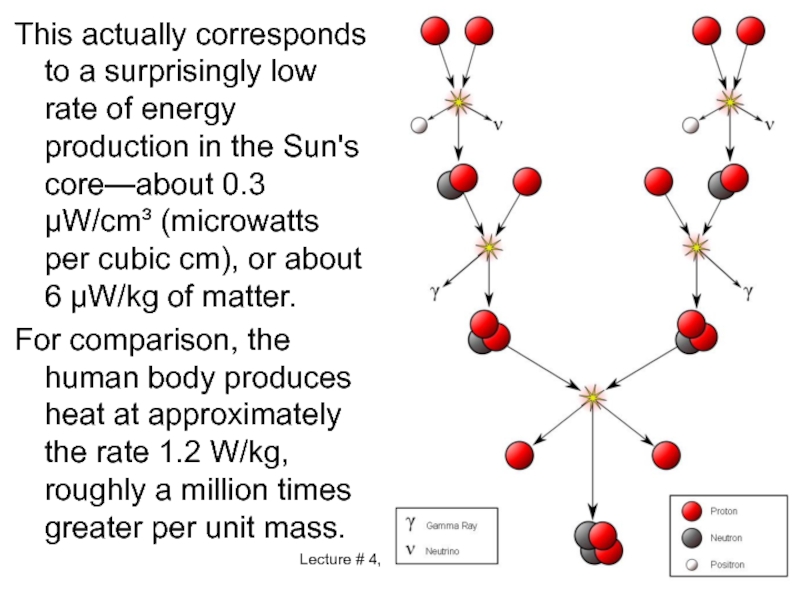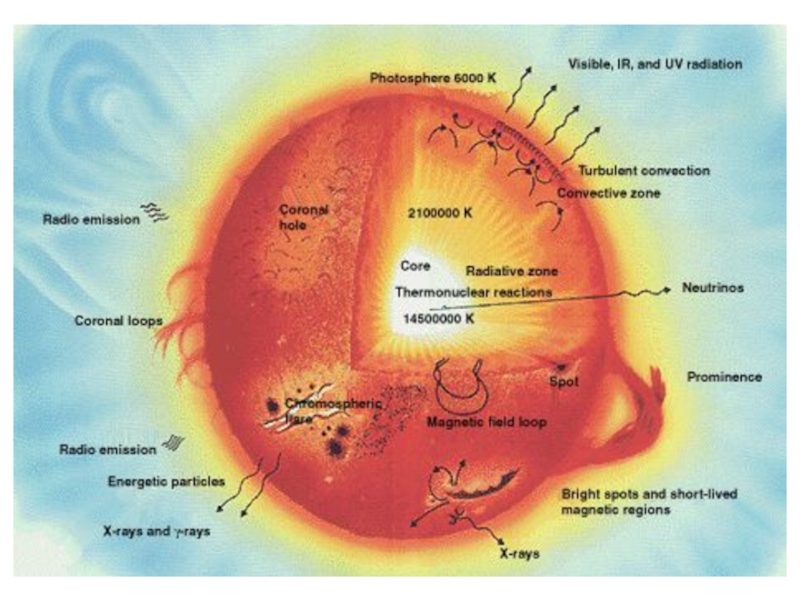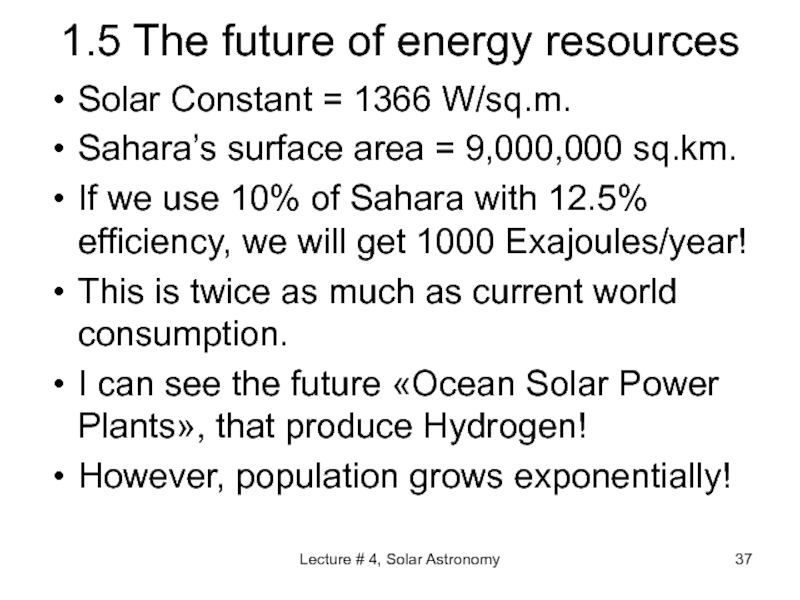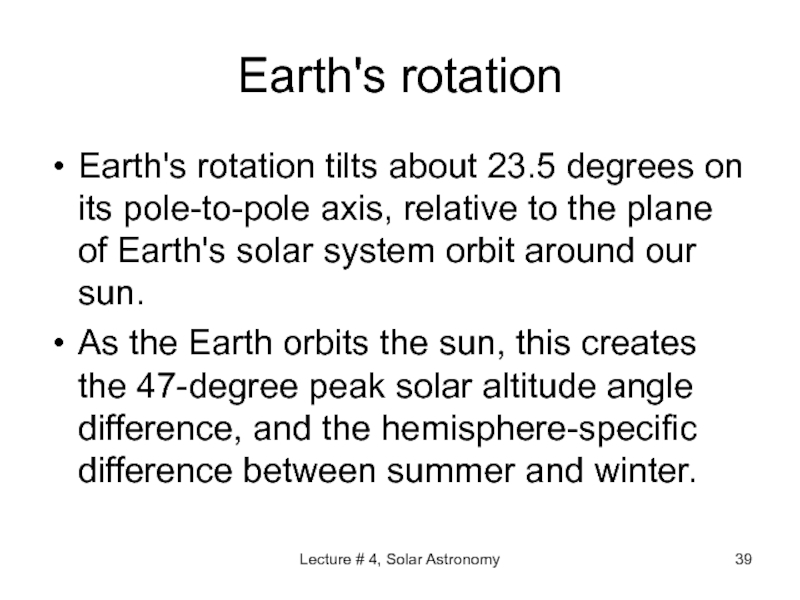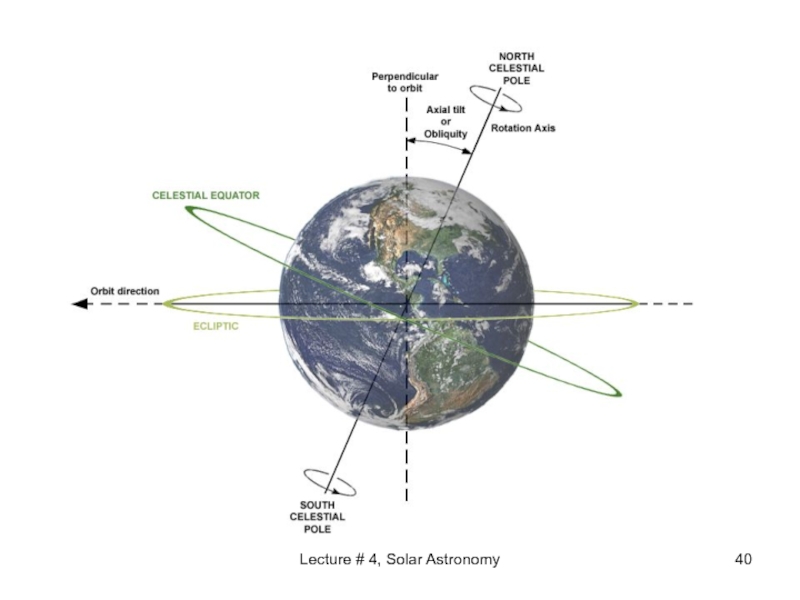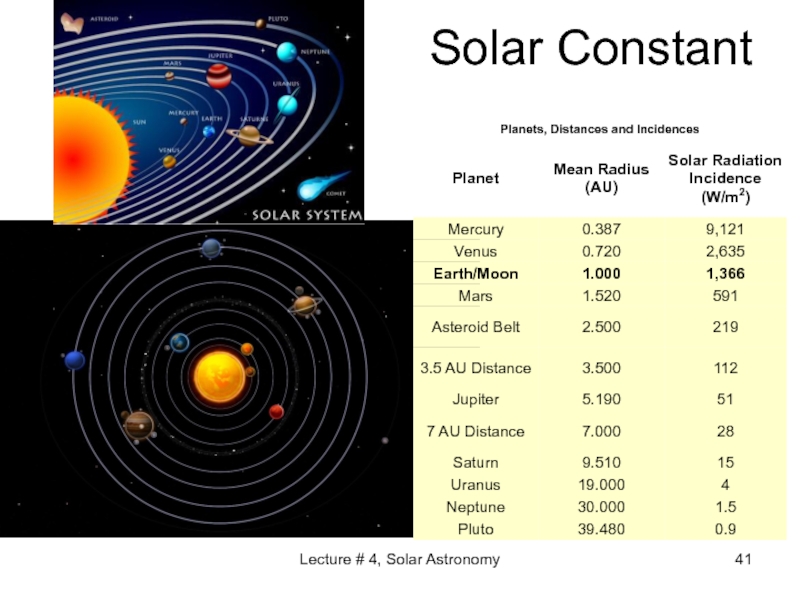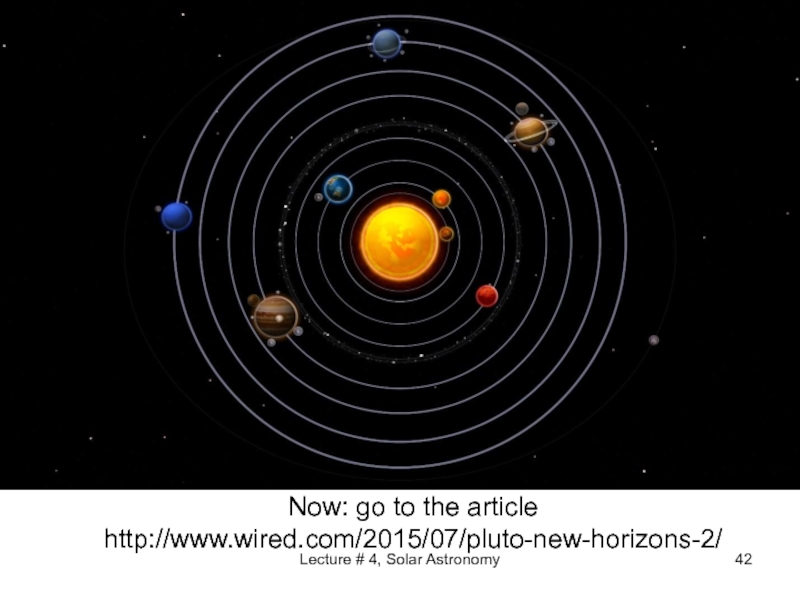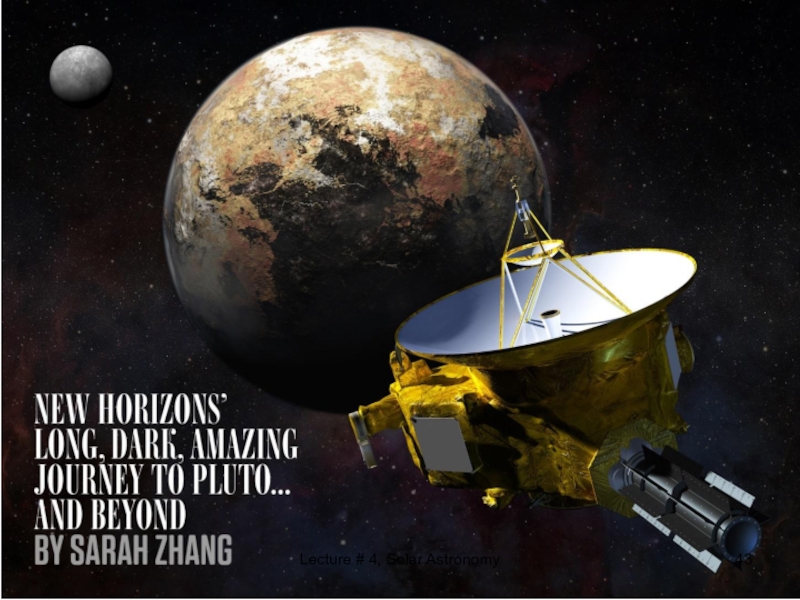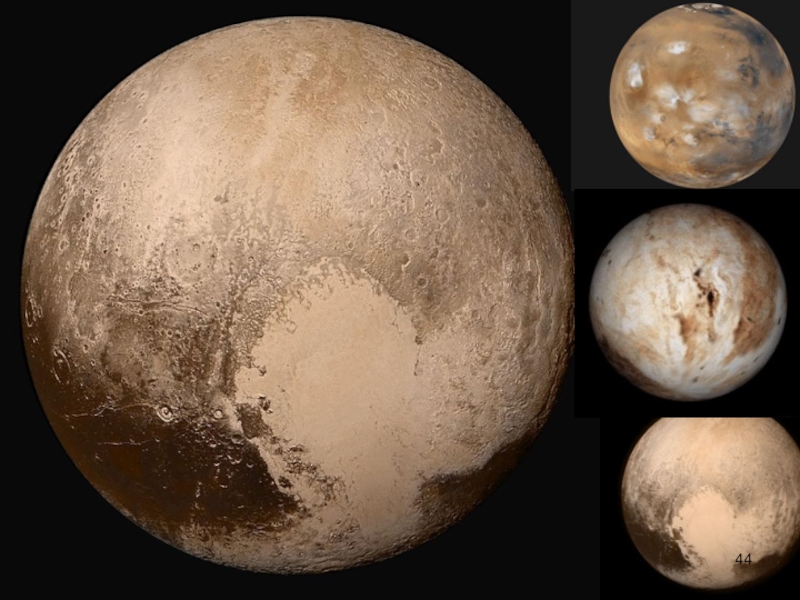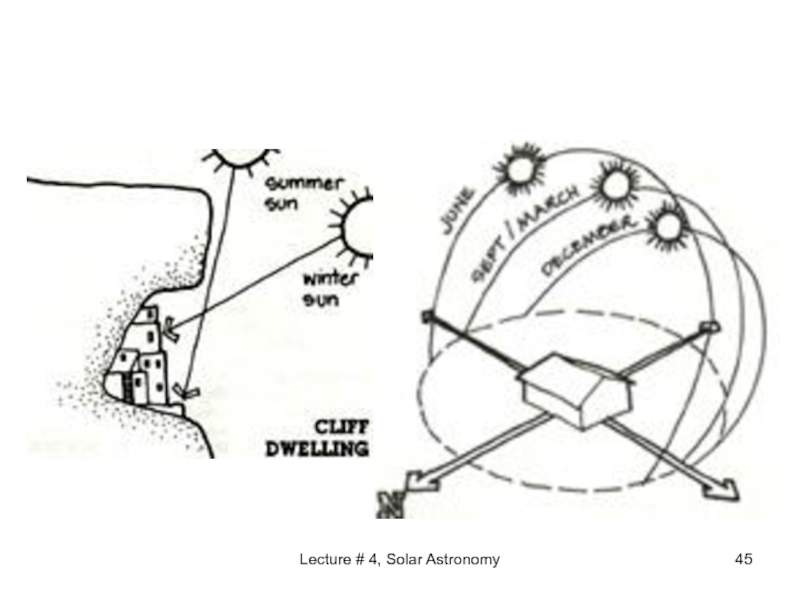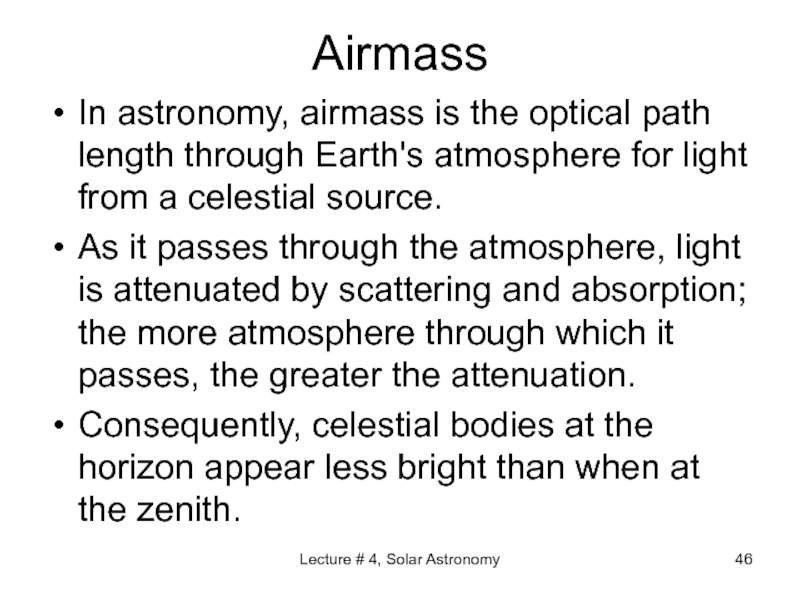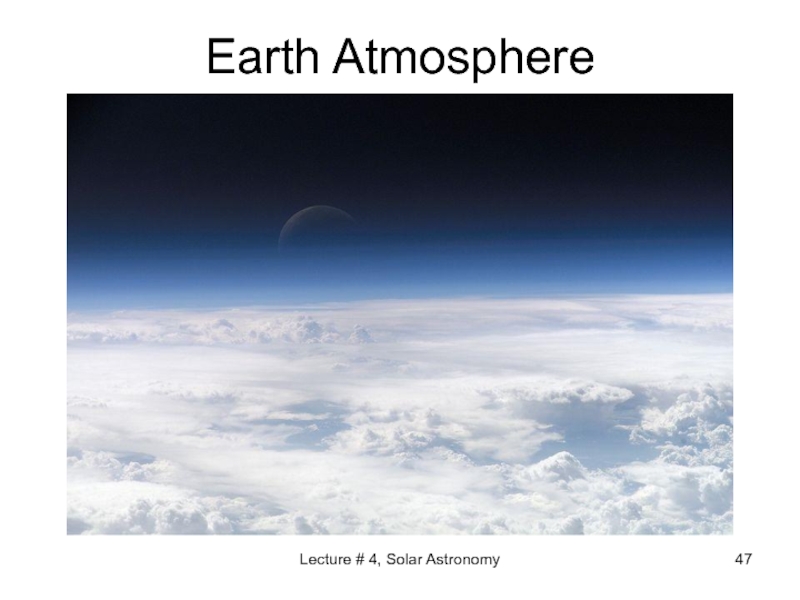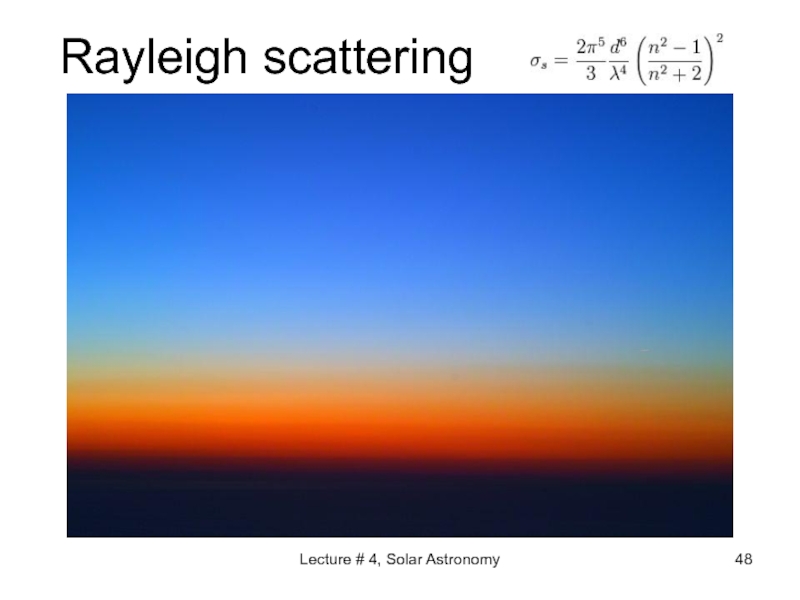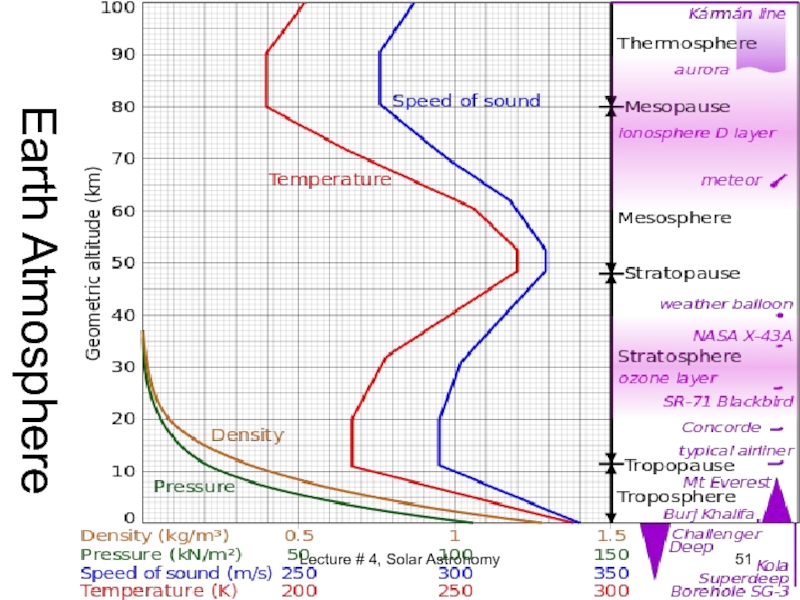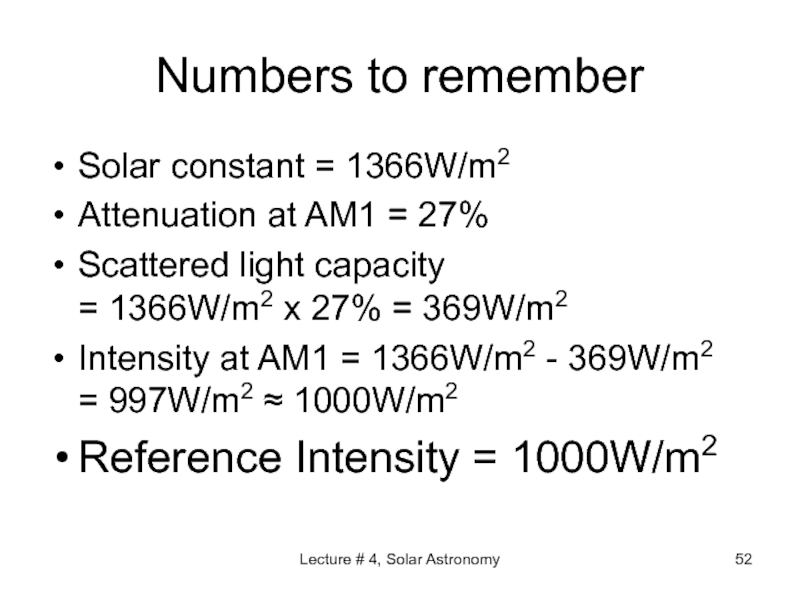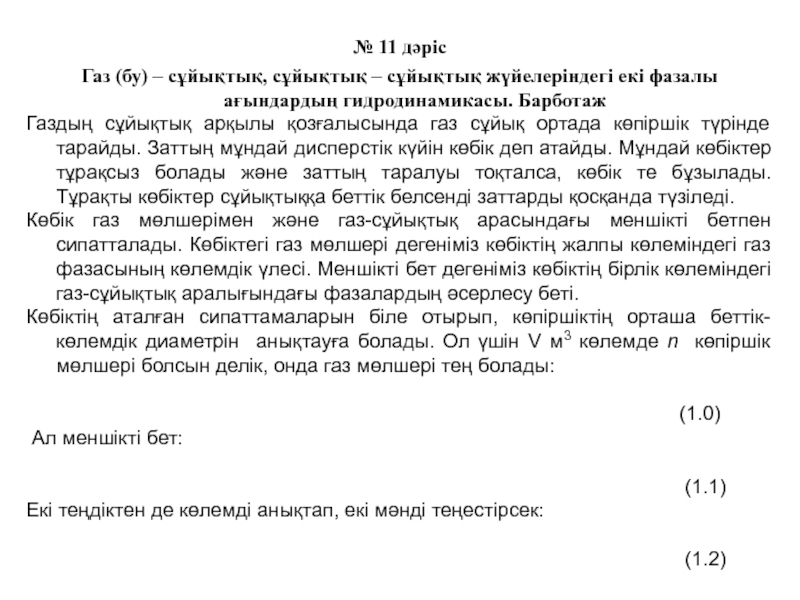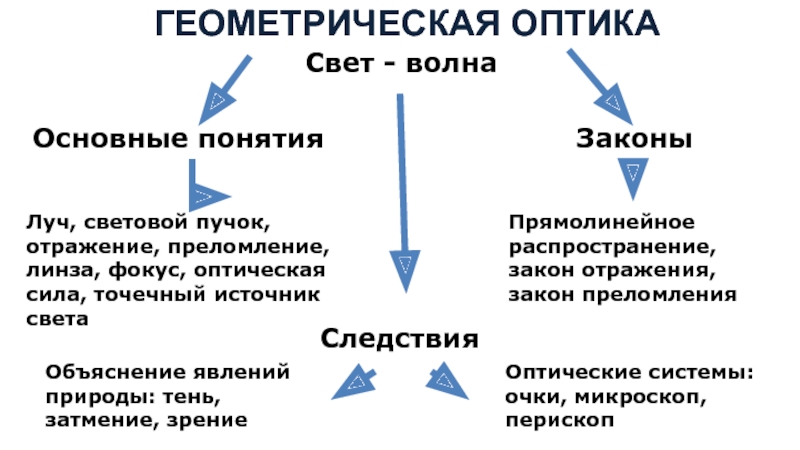- Главная
- Разное
- Дизайн
- Бизнес и предпринимательство
- Аналитика
- Образование
- Развлечения
- Красота и здоровье
- Финансы
- Государство
- Путешествия
- Спорт
- Недвижимость
- Армия
- Графика
- Культурология
- Еда и кулинария
- Лингвистика
- Английский язык
- Астрономия
- Алгебра
- Биология
- География
- Детские презентации
- Информатика
- История
- Литература
- Маркетинг
- Математика
- Медицина
- Менеджмент
- Музыка
- МХК
- Немецкий язык
- ОБЖ
- Обществознание
- Окружающий мир
- Педагогика
- Русский язык
- Технология
- Физика
- Философия
- Химия
- Шаблоны, картинки для презентаций
- Экология
- Экономика
- Юриспруденция
Energy and power, solar astronomy. (Lecture 4) презентация
Содержание
- 1. Energy and power, solar astronomy. (Lecture 4)
- 2. Lecture # 4, Solar Astronomy Energy Units
- 3. Lecture # 4, Solar Astronomy Very Small
- 4. Lecture # 4, Solar Astronomy Energy unit conversion factors
- 5. Lecture # 4, Solar Astronomy Energy and
- 6. Lecture # 4, Solar Astronomy Power Units
- 7. Lecture # 4, Solar Astronomy Power vs.
- 8. Lecture # 4, Solar Astronomy Solar Energy
- 9. Lecture # 4, Solar Astronomy The light:
- 10. Lecture # 4, Solar Astronomy Electromagnetic Spectrum
- 11. Lecture # 4, Solar Astronomy Sun Spectrum
- 12. Lecture # 4, Solar Astronomy The Sun
- 13. Lecture # 4, Solar Astronomy How this energy is generated?
- 14. Lecture # 4, Solar Astronomy How this
- 15. Lecture # 4, Solar Astronomy How this
- 16. Lecture # 4, Solar Astronomy How this
- 17. Lecture # 4, Solar Astronomy How this
- 18. Lecture # 4, Solar Astronomy
- 19. Lecture # 4, Solar Astronomy
- 20. The Sun Lecture # 4, Solar Astronomy
- 21. Lecture # 4, Solar Astronomy
- 22. Lecture # 4, Solar Astronomy
- 23. Lecture # 4, Solar Astronomy
- 24. NASA caption: Giant magnetic loops dance on
- 25. Lecture # 4, Solar Astronomy
- 26. Lecture # 4, Solar Astronomy
- 27. Lecture # 4, Solar Astronomy
- 28. Sun surface videos https://www.youtube.com/watch?v=ipvfwPqh3V4 https://www.youtube.com/watch?v=0WW1HN0iG0M https://www.youtube.com/watch?v=lpzCSZ7Eerc https://www.youtube.com/watch?v=nmDZhQAIeXM Lecture # 4, Solar Astronomy
- 29. Solar wind The total number of particles
- 30. Elementary particles flow from Sun –
- 31. Solar Wind Lecture # 4, Solar Astronomy
- 32. Aurora Borealis https://www.youtube.com/watch?v=hsMW7zbzsUs https://www.youtube.com/watch?v=Vdb9IndsSXk https://www.youtube.com/watch?v=pjgvGiEHlNs Lecture # 4, Solar Astronomy
- 33. Lecture # 4, Solar Astronomy How this
- 34. This actually corresponds to a surprisingly low
- 35. Lecture # 4, Solar Astronomy
- 36. Lecture # 4, Solar Astronomy How this
- 37. Lecture # 4, Solar Astronomy 1.5 The
- 38. Lecture # 4, Solar Astronomy
- 39. Earth's rotation Earth's rotation tilts about
- 40. Lecture # 4, Solar Astronomy
- 41. Solar Constant Lecture # 4, Solar Astronomy
- 42. Now: go to the article http://www.wired.com/2015/07/pluto-new-horizons-2/ Lecture # 4, Solar Astronomy
- 43. Lecture # 4, Solar Astronomy
- 44. Solar radiation bouncing atmosphere the theoretical daily-average
- 45. Lecture # 4, Solar Astronomy
- 46. Airmass In astronomy, airmass is the optical
- 47. Earth Atmosphere Lecture # 4, Solar Astronomy
- 48. Rayleigh scattering Lecture # 4, Solar Astronomy
- 49. Airmass Lecture # 4, Solar Astronomy “Airmass”
- 50. Airmass Atmosphere height = 8.5 ÷ 11
- 51. Earth Atmosphere Lecture # 4, Solar Astronomy
- 52. Numbers to remember Solar constant = 1366W/m2
- 53. Air mass calculations Lecture # 4, Solar Astronomy
- 54. Notion of the Cost per peak watt
Слайд 1Lecture # 4, Solar Astronomy
IE350
Alternate Energy Course
Lecture # 4
Energy and
Слайд 2Lecture # 4, Solar Astronomy
Energy Units - Calorie
Calorie (cal) = heat
1 cal ≈ 4.184 Joules
Слайд 3Lecture # 4, Solar Astronomy
Very Small Energy Unit, eV
Electronvolt (eV) -
1 eV = 1.6×10−19 J
Слайд 5Lecture # 4, Solar Astronomy
Energy and Power
If power is
E = P · t, P = E/t
If power is variable and depends on time
E = ∫P(t)dt, P(t) = dE(t)/dt
Слайд 6Lecture # 4, Solar Astronomy
Power Units
Watt (W) = using one J
kW = 1000 W
Horsepower = 735 W = 0.735 kW
MW = 1000 kW
Слайд 7Lecture # 4, Solar Astronomy
Power vs. Energy
Thus, power is the rate
Energy is what you pay for repeatedly, as much as you use the energy, the kWh-s – variable, operational cost.
Power is the capacity to use the energy
You pay for the capacity usually upfront, fixed or installation cost.
E.g. if you decide to buy an air conditioner, you need to solve a power sizing problem. You pay the fixed amount. Later you usually use only a fraction of the total capacity.
Слайд 8Lecture # 4, Solar Astronomy
Solar Energy
The SUN:
Fusion in the sun –
Temperature of the suncrust, black-body radiation – BBR
Photon energy, light speed, duality
Electromagnetic Spectrum
The solar radiation spectrum
Solar constant = 1366 W/m2.
Слайд 9Lecture # 4, Solar Astronomy
The light: particle, wave
Particle and wave
Light speed,
Photon energy, E = hn, n = frequency,
h is Planck’s constant, h = 6.626 10-34 J s h = 4.135 10-15 eV s.
l = c/n
E = hc/l
Слайд 12Lecture # 4, Solar Astronomy
The Sun
Sun has a capacity of 3.86×1026
Earth gets only two-billionth part of it.
127,400,000 km² - Earth cross-section
1.740 1017 W = 0.174 EJ/s
Armenian annual energy consumption: 0.1752 Quads
Solar Constant =1366 W/sq.m.
Average Insolation = ¼ of solar const. = 342 W/sq.m.
Слайд 14Lecture # 4, Solar Astronomy
How this energy is generated?
About 74% of
Слайд 15Lecture # 4, Solar Astronomy
How this energy is generated?
The Sun has
Слайд 16Lecture # 4, Solar Astronomy
How this energy is generated?
The Sun diameter:
1.4
Distance from Earth: 1.5 108 km, = 8.31 min at light speed
Слайд 17Lecture # 4, Solar Astronomy
How this energy is generated?
It was Albert
Слайд 24NASA caption: Giant magnetic loops dance on the sun’s horizon in
Lecture # 4, Solar Astronomy
Слайд 28Sun surface videos
https://www.youtube.com/watch?v=ipvfwPqh3V4
https://www.youtube.com/watch?v=0WW1HN0iG0M
https://www.youtube.com/watch?v=lpzCSZ7Eerc
https://www.youtube.com/watch?v=nmDZhQAIeXM
Lecture # 4, Solar Astronomy
Слайд 29Solar wind
The total number of particles carried away from the Sun
Thus, the total mass loss is about 4–6 billion tons per hour.
Composed of: - electrons, - protons - alpha particles
Lecture # 4, Solar Astronomy
Слайд 30Elementary particles flow from Sun – Solar Wind http://www.independent.co.uk/travel/europe/watch-this-beautiful-timelapse-of-the-northern-lights-over-norway-9735690.html http://www.bbc.com/news/science-environment-28690559
Lecture # 4, Solar Astronomy
Aurora Borealis
Слайд 32Aurora Borealis
https://www.youtube.com/watch?v=hsMW7zbzsUs
https://www.youtube.com/watch?v=Vdb9IndsSXk
https://www.youtube.com/watch?v=pjgvGiEHlNs
Lecture # 4, Solar Astronomy
Слайд 33Lecture # 4, Solar Astronomy
How this energy is generated?
In 1920 Sir
Слайд 34This actually corresponds to a surprisingly low rate of energy production
For comparison, the human body produces heat at approximately the rate 1.2 W/kg, roughly a million times greater per unit mass.
Lecture # 4, Solar Astronomy
Слайд 36Lecture # 4, Solar Astronomy
How this energy is generated?
most of the
Слайд 37Lecture # 4, Solar Astronomy
1.5 The future of energy resources
Solar Constant
Sahara’s surface area = 9,000,000 sq.km.
If we use 10% of Sahara with 12.5% efficiency, we will get 1000 Exajoules/year!
This is twice as much as current world consumption.
I can see the future «Ocean Solar Power Plants», that produce Hydrogen!
However, population grows exponentially!
Слайд 39Earth's rotation
Earth's rotation tilts about 23.5 degrees on its pole-to-pole
As the Earth orbits the sun, this creates the 47-degree peak solar altitude angle difference, and the hemisphere-specific difference between summer and winter.
Lecture # 4, Solar Astronomy
Слайд 42Now: go to the article
http://www.wired.com/2015/07/pluto-new-horizons-2/
Lecture # 4, Solar Astronomy
Слайд 44Solar radiation bouncing atmosphere
the theoretical daily-average insolation at the top of
Lecture # 4, Solar Astronomy
Слайд 46Airmass
In astronomy, airmass is the optical path length through Earth's atmosphere
As it passes through the atmosphere, light is attenuated by scattering and absorption; the more atmosphere through which it passes, the greater the attenuation.
Consequently, celestial bodies at the horizon appear less bright than when at the zenith.
Lecture # 4, Solar Astronomy
Слайд 49Airmass
Lecture # 4, Solar Astronomy
“Airmass” normally indicates relative airmass, the path
Airmass increases as the angle between the source and the zenith increases, reaching a value of approximately 38 at the horizon.
Airmass can be less than one at an elevation greater than sea level.
Слайд 50Airmass
Atmosphere height = 8.5 ÷ 11 km.
Earth's mean radius is 6371 km.
Airmass
E.g. at angle of approximately 60 degrees over horizon we have AM2, = 62% of solar constant.
The solar panels are often rated at AM1.5
The maximum airmass at horizon is: AM35.5 ÷ AM39
At sea level, AM1 attenuates @ 27%.
At AM10 we have 23X attenuation
At AM20 we have >10000X attenuation
Lecture # 4, Solar Astronomy
Слайд 52Numbers to remember
Solar constant = 1366W/m2
Attenuation at AM1 = 27%
Scattered
Intensity at AM1 = 1366W/m2 - 369W/m2 = 997W/m2 ≈ 1000W/m2
Reference Intensity = 1000W/m2
Lecture # 4, Solar Astronomy
Слайд 54Notion of the Cost per peak watt installed
“Peak Watt” = 1000W
Is the power produced at normal incidence of solar radiation @ 1000W/m2.
$/Wp - Easy way to compare various solar conversion devices.
Mostly useful for electric power generation devices, such as for: Hydro; PV; Wind, Solar Thermal Electric, etc.
Lecture # 4, Solar Astronomy
